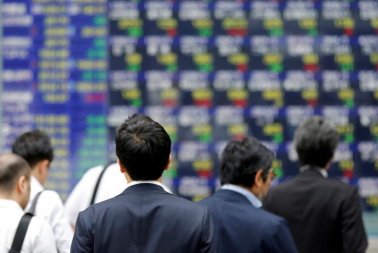Asia shares seek to extend rally, dollar at mercy of bears

SYDNEY (Reuters) - Asian shares looked to extend their recent bull run on Monday amid upbeat corporate earnings and strong global economic growth, while more rumblings from the White House about “unfair” trade practices kept the US dollar on the defensive.
MSCI’s broadest index of Asia-Pacific shares outside Japan .MIAPJ0000PUS added 0.19 percent in early trade and aiming for a 12th straight session of gains. It is up nearly 8 percent for the year so far.
Japan's Nikkei rose 0.2 percent, though the export sector was again struggling with a rising yen.
Hong Kong has been the best performer for the year with a rise of almost 11 percent, followed by Shanghai blue chips with gains of nearly 9 percent.
Wall Street has likewise been on a tear. Just last week, the Dow rose 2.08 percent, the S&P 500 2.22 percent and the Nasdaq 2.31 percent.
Quarterly earnings growth for the S&P 500 is estimated at 13.2 percent, according to Thomson Reuters data, up from 12 percent at the start of the year. Of the 133 companies in the index that have reported, almost 80 percent beat forecasts.
Another 36 percent of the S&P 500 is due to report this week including heavy hitters Apple, Alphabet, Facebook, Microsoft and Amazon.
The rush to equities combined with the risk of faster global inflation, has been a major negative for sovereign bonds with yields rising across much of the developed world.
Yields on US two-year Treasuries US2YT=RR have risen steadily to their highest since 2008 and are fully priced for a rate hike by the Federal Reserve in March.
The central bank holds its next meeting on Wednesday, the last for Chair Janet Yellen, and analysts suspect the statement will only cement expectations for a March move.
WORDS MATTER
The inexorable increase in Treasury yields has not, however, been enough to rescue the US dollar which sank to three-year lows last week as US officials welcomed a weaker currency. President Donald Trump did try and walk some of that back late in the week but by then the damage had been done. Indeed, in an interview shown on Sunday, Trump threatened to confront the European Union over what he calls “very unfair” trade policy toward the US.
Words“ in the world of FX do matter,” said Deutsche Bank strategist George Saravelos. “The US is reengaging with a weak dollar policy similarly to the 1994-95 period.”
This was happening while the sum of trade and investment flows into the United States was shrinking. The opposite was happening in the euro zone where the German export engine was powering an ever-expanding current account surplus.
“We continue to target $1.30 in EUR/USD for this year,” Saravelos concluded.
Early Monday, the euro was steady at $1.2425 having reached a three-year peak of $1.2538 last week. The dollar had also touched a four-month trough on the yen at 108.28 and was last changing hands at 108.54.
Against a basket of major currencies, it was near the lowest since late 2014 at 89.053 .DXY.
The dollar faces a bevy of US economic tests this week including releases on inflation, manufacturing and payrolls.
The currency’s decline has been a boon for many commodities with gold making a 17-month top last week and last trading at $1,352.27 an ounce XAU=.
Oil prices reached their highest in three years and Brent crude futures LCOc1 were holding atop $70 at $70.42 a barrel. US crude futures CLc1 were up 5 cents at $66.19.







